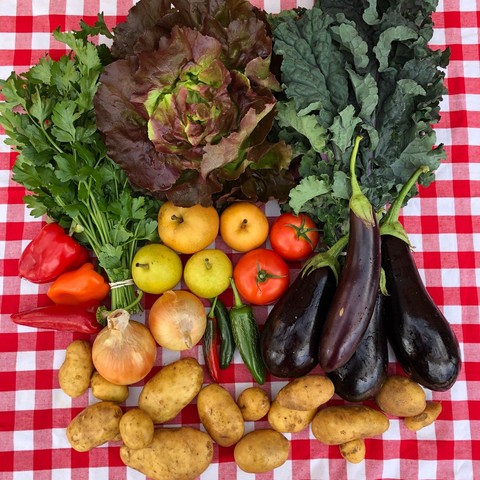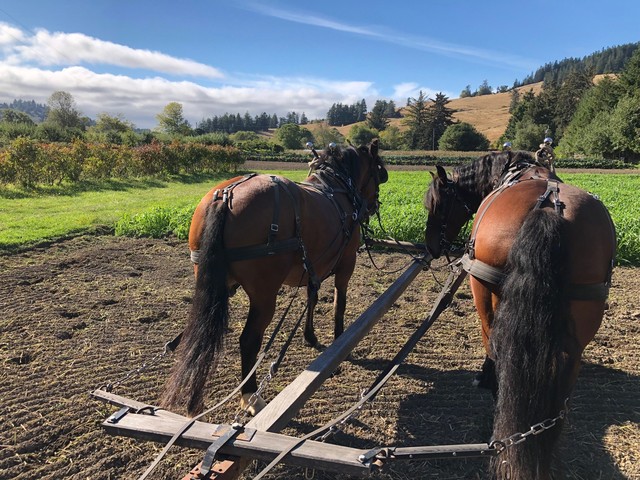- Eggplant
- Yellow Onion
- Sweet Peppers
- Hot Peppers
- Potatoes - These are our yellow storage potatoes, a great variety called "Nicola." We're giving them out right on the heels of last week's new potatoes because we've had mind-boggling high yields on this variety this year. A "good" potato year would be about 500 pounds per bed, but we've been pulling upwards of 800 pounds of Nicola per bed. It means we're currently buried in potatoes. Our walk-in cooler is stacked floor to ceiling with spuds, which makes packout days a black diamond Tetris challenge. We still have two more beds in the field to dig, so we need to offload some spuds and make room for the final harvest. All to say, we thank you for helping draw down our potato stores a little this week! They are an excellent keeper, so if you still have plenty of new potatoes from last year, just bag up your Nicola and keep them in the fridge. They'll hold for months.
- Tomatoes
- Chojuro Asian Pear - This is my favorite Asian pear. It's the one with the deep bronze skin. Dense, deeply-flavorful, with big hints of butterscotch when they're fully ripe. We have four different Asian pear varieties in our orchard, all of them distinct. If you were to compare them all to beer, Chojuro is the porter.
- Nijiseiki Asian Pear - This is Uma's favorite. It's the yellow-skinned variety, super juicy, mild, light, bright. Think, Pacifico or Corona.
On Rotation
- Kale
- Napa Cabbage
- Italian Parsley
- Curly Parsley
- Lettuce
The horses and I put ourselves to the task of seeding the first wave of fall cover crops on Saturday in hopes of taking advantage of all the free irrigation that fell from the sky Sunday and Monday. September and October bear a lot of resemblance to spring on the farm: a big time of transition that requires hawkish attention to the weather forecast and a constant dance with sun and rain. It's the time of year when we hope for rain every week, but not too much. The perfect week gives us an inch or two on one side of the week or the other, and then 4 or 5 sunny days to get back into the field, seed more cover crops, get caught up on fieldwork, and then revel in the next rain.
In the spring we're making the shift from overwintered cover crops to our seasonal cash crops. In the fall, it's the reverse: cash crops come out to be replaced by cover crops. So what's a cover crop? It's a mix of species - typically grains and legumes - that we grow to nourish and replenish our soil, to add organic matter to the field, to provide erosion protection during the winter, and to provide habitat for beneficial organisms that are part of our farm ecosystem. Cover crops are the backbone of our soil health, and also happen to be my favorite thing to plant and grow. We use different mixes of cover crop species depending on what cash crop is rotating into that space the next year: early crops get cover crops that either winter-kill (die back in a frost) or are easy to incorporate in the cool, wet conditions of early spring - things like Sudan grass, field peas, clover. Late-season cash crops are preceded by cover crops that we can mow and re-grow to generate maximum biomass into early summer, and/or by species like crimson clover that don't bloom until May but are gorgeous and provide ample food for the bees when they do. There are all kinds of considerations that go into the cover crop planning and it's always a fun puzzle to solve as we map out the cash crop rotation and subsequent cover crop plan at this time of year.
The mix I seeded on Saturday was our standby combo of Saia oats, red clover and common vetch. The oats grow taller than me by spring and provide a fanastic amount of organic matter to the soil. The vetch provides nitrogen to the field. The clover hangs out in the understory until we mow the oats, at which point the clover either gets turned in with the oats and vetch or is to left to become the dominant species in the mix. Red clover will persist as a perennial and can be mowed and grow back over and over to provide ample nitrogen and organic matter. It makes for super-yummy soil, especially when it can work its magic over the course of 9 months to a year, or longer.
I love cover cropping because it's the moment we give back to the soil, after a summer of taking. And I love it because it involves working my horses on these beautiful fall days, quiet and steady.


